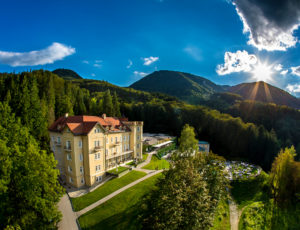When you think of the vast area of volcanic coastline that stretches from the city of Naples to Monte di Procida, known as the Campi Flegrei (the origin of the name refers to the Latin verb “flagro” = burn, for the presence of numerous volcanic craters and geological phenomena related to them), our thoughts go to the numerous archaeological evidence that the exceptional nature of these places has preserved.
the ancient city of Cuma constitutes without doubt one of the best examples.
Still uncertain date are its historical origins, although most scholars agree in laying the foundation of the city in the eighth century BC (730 BC) by Greek colonists calcidesi already present in the neighboring island of Pithecussa (modern Ischia, at the time intended for storing and sale / trade in goods), who decided to set up a real polis on the mainland which gave the name of Cuma (from the greek = Kyme wave, referring to the shape of the peninsula on which it stood).
If, on the one hand, little is knows the exact origin of the first Greek city of the West, no uncertainty concerns instead the fame and prestige that in no time the city acquired throughout the region flegrea.
Between the seventh and sixth centuries BC, the dominion of Cuma reached its maximum splendor, thanks to the presence of bays and coves that allowed an effective system of territorial control based on the construction of ports-fortress.
the popularity and reputation of Cuma, which set off the founders of the same city of Neapolis (from greek = “new city”), grew to such an extent that the Etruscans of nearby Capua began to perceive the danger of this new maritime hegemony. So it was that the largest Italian populations of the time (Dauni, Auruncis, Etruscans of Capua) allied themselves with each other to try to contain the size, up to the two historic battles (in 524 BC the first; the second in 474 BC) in which the Cumans defeated and stopped the enemies
it is curious to read what we pass on the historical sources (usually always “close” to the winners) of these episodes: according to Dionysius of Halicarnassus Cumane forces would be able to defeat an opposing army of 500,000 infantry and 18,000 cavalry, with only 4,500 men and 600 horses. The figures are obviously biased, but it is interesting passing mention to grasp the meaning of this deliberate exaggeration in favor of Cuma.
However, even for this thriving city decline not long in coming. Occupied first by the people of sannitico Osci, was subdued by the Romans shortly after that, in 334 BC, declared the civitas sine suffrage (allied city without voting rights), transforming it into a faithful municipium under the jurisdiction of Rome.
Cuma lost its role of hegemony over the entire area flegrea, but because of his loyalty he received, as a reward, the free use of the Latin language in official documents and full citizenship rights .
the oldest archaeological investigations on what remains of the first Greek colony of the West began in 1606, with some surveys in the necropolis, but only in the late nineteenth century and even more in the course of the twentieth century, the area was systematically investigated.
Inside of the Archaeological Park are reported several places worthy of note: the area of the Acropolis (upper city) with the remains of the Temple of Apollo and the cd. Temple of Jupiter (named the early antiquarians who brought to light, although there is no concrete evidence to date of dedications to this deity), the cd. Sybil’s Cave, the Roman Crypt, and the area of the lower city and its monuments.
A special mention to the importance mythological plays deserves undoubtedly the cd. Sybil’s Cave (currently not open because of technical audits in progress), an artificial tunnel built in tuff, 131 m long and 5 m high, trapezoidal the top (seismic ploy used by the Greeks) and rectangular bottom, whose date is still uncertain, although most scholars agree in place it is likely between the fourth and third centuries BC
Along the west wall the Romans realized 9 holes from the same trapezoidal shape to illuminate the environment and provide a continuous air. The site plays a mysterious charm, almost mystical, as here, according to ancient sources, he resided the cd. Sibyl Cumana, the priestess of Apollo famous for its oracles and prophecies, which, inspired by the gods, transcribing the prophecies in the form of verses on palm leaves that the wind coming from the multiple openings of the place he enjoyed mixing, thus making the pinned “cryptic”.
Recent studies have wanted you actually recognize a military structure with defensive purpose for the city and the harbor below, enriched in Roman times by a system of terraces.
a military function very similar was also carried out from the nearby Roman Crypt, also a tunnel dug into the tufa, made at the time of Augustus as an underground connection between the old port of Cuma and the new Portus Iulius. The area, reused in Christian times as the burial area, still retains traces engraved on the walls of Christian worship.
No less interesting appear the remains of the monuments in the lower town, considered the political and commercial center Cuma: the Forum with the Capitol, the Baths, the cd. Masseria del Gigante, the Amphitheatre, and the cd. Arco Felice.
The hole looks like a rectangular square characterized by a rich road system and bounded on the west by the Capitolium, a temple probably from Osco-Samnite as shown by the presence of an inscription in Oscan found in situ, later dedicated to the Capitoline Triad (Jupiter, Juno and Minerva) as provided for the Roman tradition on this model of the temple in Rome at the Capitol.
a North of the Capitol, are the ruins of the Baths of the Forum, made according to the traditional pattern of the Roman baths, with the alternation of cold environments (frigidarium) in warm areas (steam bath), separated by a corridor (tepidarium). By traces of mosaics in black and white tiles and marble coverings still traceable seems be a whole rather gorgeous and richly decorated.
Continuing the visit you can not leave out the cd. Masseria del Gigante, a building located along the east side of the Forum that has undergone several renovations over the centuries until its transformation in 1700 into a farmhouse. The structure, which owes its name to the finding in its vicinity of the remains of a colossal statue of Jupiter later identified as one of three sculptures of the triad present in the Capitol, was initially interpreted as the seat of the Senate Cuma, but recent excavations conducted under the most modern environments instead have unearthed the remains of a Roman temple, fitted with a colonnaded courtyard, thus overcoming the initial interpretation.
a final mention, no less worthy of interest deserve the Amphitheatre, which has been preserved almost entirely the auditorium, and the Arco Felice, monumental entrance to the city along the eastern side, where the original building dated to 95 AD unfortunately, very little remains.
To be sure, in conclusion, it must be said that everything beautiful and fascinating has come down to us today unfortunately is likely much. The majority of the archaeological remains undoubtedly requires maintenance of a continuous and constant, the only able to preserve from decay and ruin such immense beauty. What we hope is that more and more controls and preventive interventions can preserve a heritage so rich and perhaps still little known and valued, which is today the archaeological area of Cuma.
You might also like
More from Archivio
(Italiano) La proposta di Rimske Terme per i ponti di primavera
(Italiano)I lunghi ponti del 25 aprile e del 1° maggio sono da sempre un’occasione per trascorrere qualche giorno di vacanza …
(Italiano) Trytaly: la vera cucina italiana per i turisti di tutto il mondo
(Italiano)Quante volte vi è capitato di viaggiare all’estero e di rimanere delusi dalla cucina del posto? Troppo spesso, infatti, succede di …
(Italiano) The Party Edit by Pronovias: moderna, attuale, all’avanguardia
(Italiano)Pronovias, il marchio leader mondiale nel settore della sposa di lusso, presenta una nuova linea, Pronovias The Party Edit, disponibile …












